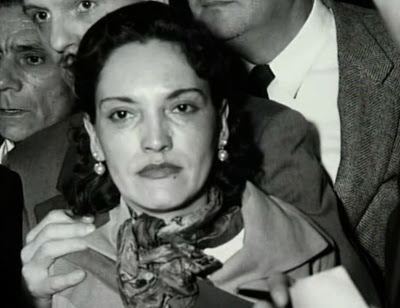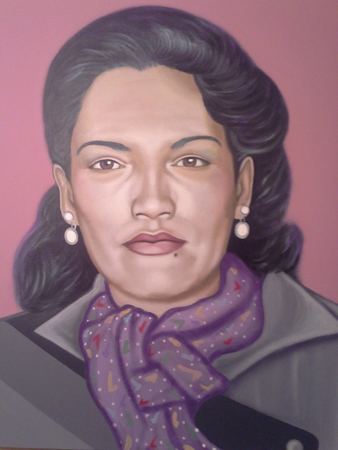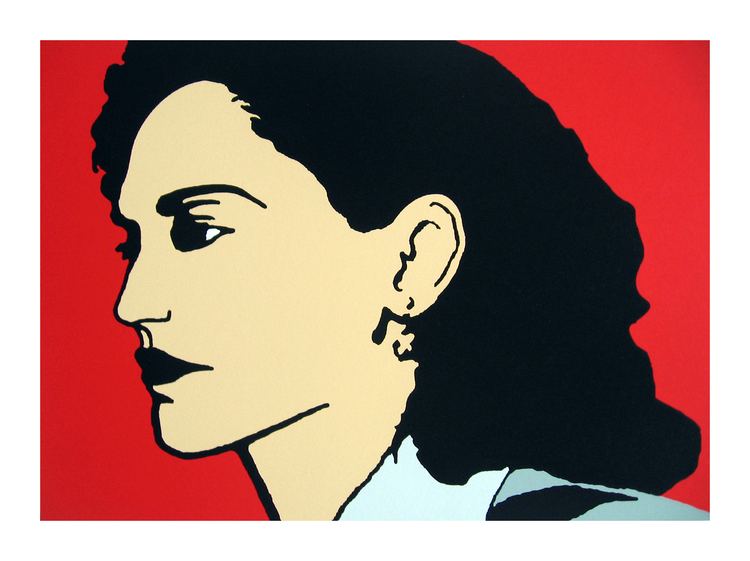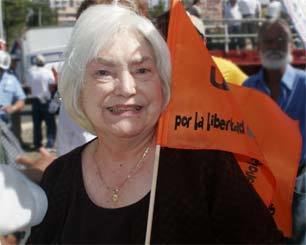Religion Roman Catholicism Spouse(s) Sergio Irizarry | Name Lolita Lebron | |
 | ||
Movement Puerto Rican Independence Similar Rafael Cancel Miranda, Pedro Albizu Campos, Blanca Canales | ||
Reclamando patria entrevista con lolita lebron 1979
Lolita Lebrón (November 19, 1919 – August 1, 2010) was a Puerto Rican nationalist who was convicted of attempted murder and other crimes after leading an assault on the United States House of Representatives in 1954, resulting in the wounding of five members of the United States Congress. She was freed from prison in 1979 after being granted clemency by President Jimmy Carter.
Contents
- Reclamando patria entrevista con lolita lebron 1979
- Lolita lebron ataca el congreso 1954
- Early life
- Political activism
- Attack preparations
- The attack
- Trial and imprisonment
- Later years death and legacy
- Legacy
- Puerto rico despide a lolita lebr n
- References

Lebrón was born and raised in Lares, Puerto Rico, where she joined the Liberal Party. In her youth she met Francisco Matos Paoli, a Puerto Rican poet, with whom she had a relationship. In 1941, Lebrón migrated to New York City, where she joined the Puerto Rican Nationalist Party, gaining influence within the party's leadership. Within the organization she advocated socialist and feminist ideas.

In 1952, after the Constitution of the Commonwealth of Puerto Rico was promulgated, the Nationalist Party began a series of revolutionary actions, including the Jayuya Uprising. As part of this initiative, Pedro Albizu Campos ordered her to organize attacks in the United States, focusing on locations that were "the most strategic to the enemy". She became the leader of a group of nationalists, who attacked the United States House of Representatives in 1954. She was incarcerated as a result. Lebrón remained imprisoned 25 years, when President Carter issued pardons to the group involved. After their release in 1979, the nationalists returned to Puerto Rico, where independence movements received them with a celebration. During the following years she continued her involvement in pro-independence activities, including the Navy-Vieques protests. Her life would be subsequently detailed in books and a documentary. On August 1, 2010, Lebrón died from complications of a cardiorespiratory infection.
Lolita lebron ataca el congreso 1954
Early life

Lebrón (birth name: Dolores Lebrón Sotomayor ) was one of five siblings born in Lares, Puerto Rico to Gonzalo Lebrón Bernal and Rafaela Soto Luciano, the other four were Aurea, Augusto, Gonzalo Jr. and Julio. Lebrón was raised in Hacienda Pezuelas in Pezuelas, a barrio in Lares. Gonzalo Lebrón worked as the hacienda's foreman earning a salary of $30 a month and was allowed to live in a "small house" where he was also allowed to plant produce for his family.

In Pezuelas Lebrón began her education in a small community school. Early in her life, Lebrón contracted pneumonia when she accidentally fell into a gutter that was full of water, as a consequence she grew with a frail body and was unable to keep up with the constant activities of her brothers without feeling fatigue. She developed an introverted and contemplative personality, often spending her time admiring nature around the hacienda.

From Pezuelas the family moved to Mirasol, also in Lares, where Gonzalo Lebrón administered an hacienda owned by Emilio Vilellas. There she received a better education, attending a local public school. When Lebrón completed the sixth grade she attended the Segunda Unidad Rural, a middle school located in Bartolo, an adjacent barrio. She concluded her formal public school education in the eighth grade.

Lebrón had uncommonly good looks and when she was a teenager won the first place in the annual "Queen of the Flowers of May" beauty contest held in Lares. Although her father was an atheist, Lebrón was baptized in the Catholic faith when she was fourteen years old along with her other siblings. During the baptism celebration she met Francisco Matos Paoli, who became her first boyfriend. Paoli and Lebron wrote letters to each other where they exchanged the poetry which they wrote. According to Jossianna Arroyo, Lolita wrote "more mystical poetry, centered on what she called “visions” filled with religious symbolism." Paoli's family opposed their relationship because they considered Lebrón a jíbara (peasant). Her father also opposed this relationship and ordered her to stop writing to Paoli. However, they both continued to write to each other until he moved out of the city.
Lebrón eventually moved to San Juan, where she studied sewing and continued her correspondence with Paoli. She felt obligated to return to Lares because her father was severely affected by tuberculosis. The family was forced to abandon the house in the hacienda, but was later received by Ramón Santiago who provided them with a new house.
Lebrón took upon herself the responsibility of taking care of her father. She would travel to a nearby town to buy medicines for her father which she gave him every seventy minutes. For seven days she didn't sleep or eat while attending him. Following his death Lebrón began working by weaving clothes.
Political activism
Although Lebrón was a member of the Liberal Party from a young age, she didn't display any interest in politics. However, her posture changed after March 21, 1937, when a group of militants from the Puerto Rican Nationalist Party were killed during a peaceful protest which became known as the Ponce massacre. Lebrón who was eighteen years old at the time, developed a nationalistic ideology following this event. During this timeframe, Lebrón had a relationship with a local engineer, following the advice of her family. When she was twenty-one years old she gave birth to her first daughter Gladys, who was left in Rafaela Luciano's custody after Lebrón was separated from her husband and moved to New York City. After she arrived in New York City, she started to experience problems finding employment, mostly because she did not fully understand English. Lebrón worked as a seamstress in several factories. She was fired from some of her jobs because she was considered a "rebel by her bosses" after she protested against the discrimination which she witnessed against Puerto Rican workers. This influenced her nationalistic views even further and she eventually established contact with members of the Puerto Rican Liberation Movement. She enrolled at George Washington College, where she studied for two years during her free time from work. She married again when she was twenty-two years old and gave birth to her second child, whom she would send to Puerto Rico to live with her mother, a year later. Lebrón decided to divorce her husband because she felt that he was oppressing her. In 1943, there was a massive migration of Puerto Ricans from Puerto Rico to New York, composed mostly of jibaros seeking employment. Lebrón grew increasingly frustrated when she observed how they were forced to live in poverty and under social decadence and she increased her work within nationalist circles. In 1946, she formally became a member of the Puerto Rican Nationalist Party, following the advice of a friend. During this time she developed an admiration for the Party's president Pedro Albizu Campos, studying and memorizing his biography and ideals. After joining the party, Lebrón inadvertently included some of her own initiatives within the organization's ideals, these were influenced by socialist and feminist ideals. Seeking more involvement in society and politics for women, new economic systems and social reforms that would protect women and children. Her constant involvement in the party's affairs earned her several high-ranking positions, among them those of secretary, vice-president, and executive delegate of its delegation in New York.
On May 21, 1948, a bill was introduced before the Puerto Rican Senate which would restrain the rights of the independence and nationalist movements in the island. The Senate at the time was controlled by the PPD and presided by Luis Muñoz Marín approved the Bill. The Bill, also known as the "Ley de la Mordaza" (Gag Law), made it illegal to display a Puerto Rican flag, to sing a patriotic tune, to talk of independence, and to fight for the independence of the island. The Bill which resembled the anti-communist Smith Law passed in the United States, was signed and made into law on June 10, 1948, by the U.S.-appointed Governor of Puerto Rico, Jesús T. Piñero and became known as "Ley 53" (Law 53). In accordance to the new law, it would be a crime to print, publish, sale, to exhibit or organize or to help anyone organize any society, group or assembly of people whose intentions are to paralyze or destroy the insular government. Anyone accused and found guilty of disobeying the law could be sentenced to ten years of prison, be fined $10,000 (US) or both. According to Dr. Leopoldo Figueroa, a member of the Puerto Rico House of Representatives, the law was repressive and was in violation of the First Amendment of the US Constitution which guarantees Freedom of Speech. He pointed out that the law as such was a violation of the civil rights of the people of Puerto Rico.
On November 1, 1950, following a series of uprisings in Puerto Rico which included the Jayuya Uprising and the Utuado Uprising which culminated in a massacre, Oscar Collazo and Griselio Torresola invaded Harry S. Truman's residence, carrying a letter written by Albizu Campos and addressed to Truman. A shootout erupted between the duo and the guard stationed there, killing Torresola. Collazo was badly injured but survived and was sentenced to death by an American jury. The Puerto Rican Nationalist Party claimed that their goal was to "draw attention to the fact of Puerto Rico's continued colonial status", while the American government and media treated it as an assassination attempt. Following the sentence, Lebrón quickly joined the "Committee for Oscar Collazo's defense", participating in numerous public manifestations which eventually led to a presidential pardon. On July 25, 1952, the official name of Puerto Rico was changed to Estado Libre Associado (commonwealth of the United States) as a constitution was promulgated by Luis Muñoz Marín, the islands' first elected governor. In 1954, Lebrón received a letter from Albizu Campos, in which he declared his intention to order attacks on "three locations, the most strategic to the enemy".
Attack preparations
Albizu Campos had been corresponding with 34-year-old Lebrón from prison and chose a group of nationalists who included Rafael Cancel Miranda, Irvin Flores and Andres Figueroa Cordero to attack locations in Washington, D.C. Upon receiving the order she communicated it to the leadership of the Nationalist party in New York and, although two members unexpectedly disagreed, the plan continued. Lebrón decided to lead the group, even though Albizu Campos did not order her to directly take part in the assault. She studied the plan, determining the possible weaknesses, concluding that a single attack on the House of Representatives would be more effective. The date for the attack on the House of Representatives was to be March 1, 1954. This date was chosen because it coincided with the inauguration of the Conferencia Interamericana (Interamerican Conference) in Caracas. Lebrón intended to call attention to Puerto Rico's independence cause, particularly among the Latin American countries participating in the conference.
The attack
On the morning of March 1, Lebrón traveled to Grand Central Terminal, where she rendezvoused with the rest of the group. Once they arrived at the United States Capitol, Rafael Cancel Miranda suggested that the attack should be postponed because it was late and rainy. Lebrón responded, "I am alone" and continued towards the building's interior. The group followed, considering the attack a coup d'état, the most important revolutionary act in the history of the Puerto Rican independence movement, the fourth uprising after the Grito de Lares, the Intentona de Yauco and the Jayuya Uprising. The other members of the group seemed serene and optimistic while rushing towards the legislative chamber.(p. 136)
When Lebrón's group reached the visitor's gallery above the chamber in the House, they sat while the representatives discussed Mexico's economy. Shortly thereafter, Lebrón gave the order to the other members, the group quickly recited the Lord's Prayer; then Lebrón stood up and shouted "¡Viva Puerto Rico Libre!" ("Long live a Free Puerto Rico!") and unfurled the Flag of Puerto Rico. The group opened fire with semi-automatic pistols. Lebrón claimed that she fired her shots at the ceiling, while Figueroa's pistol jammed. Some 30 shots were fired (mostly by Cancel, according to his account), wounding five lawmakers; one representative, Alvin Bentley from Michigan, was seriously wounded in the chest. Upon being arrested, Lebrón yelled "I did not come to kill anyone, I came to die for Puerto Rico!".
Trial and imprisonment
Lebrón and her comrades were charged with attempted murder and other crimes. She was imprisoned in the Federal Correctional Institution for Women in Alderson, West Virginia. The trial began on June 4, 1954, with judge Alexander Holtzoff presiding over the case, under strict security measures. A jury composed of seven men and five women was assembled, their identities were kept secret from the media.
The prosecution was led by Leo A. Rover, as part of this process 33 witnesses testified. Ruth Mary Reynolds, the "American/Puerto Rican Nationalist" and the organization which she founded "American League for Puerto Rico's Independence" came to the defense of Lebrón and the three other Nationalists. Lebrón and the other members of the group were the only defense witnesses, as part of her testimony she reaffirmed that they "came to die for the liberty of her homeland".
During the early part of their trial she remained calm, complaining through her lawyers alleged disrespect for the flag while it was being produced as evidence. She loudly protested when the defense suggested that the group might have suffered from mental instability while committing the deed. On June 16, 1954, the jury found all four defendants guilty. On the morning of July 8, 1954, Lebrón learned of her son's death minutes before the sentence was to be announced. She was quiet at the beginning of the hearing, but at one point, unable to contain herself, she became hysterical. Rover demanded the death penalty, but Holtzoff chose to sentence them to the longest terms of imprisonment possible. In Lebrón's case this was between sixteen and fifty years, depending on her behavior.
Back at the prison, she went into shock upon receiving official notice of her son's death and did not speak for three days. On July 13, 1954, the four nationalists were taken to New York, where they pleaded not guilty to the charges of "trying to overthrow the government of the United States". One of the witnesses for the prosecution was Gonzalo Lebrón Jr., who testified against his sister. On October 26, 1954, judge Lawrence E. Walsh found all the defendants guilty of conspiracy and sentenced them to six additional years in prison.
Lebrón has stated that the first two years in prison were the most difficult, having to deal with the deaths of her son and mother. Communication with her siblings was non-existent. Lebrón refused to accept letters from her sister because only letters written in English were permitted in the prison. Communication with the outside world was not allowed then. Later it was granted after several inmates went on a hunger strike that lasted three and a half days. Due to her participation, Lebrón was not allowed to perform work outside of her cell for some time, although she was eventually allowed to work at the infirmary. While in prison, a group of judges offered her parole in exchange for a public apology, which she indignantly rejected.
After completing the first 15 years of the sentence, Lebrón's social worker told her that she could ask for parole, but she did not display interest in the proposal, never signing the required documentation. Due to this lack of interest, she was mandated to attend a meeting before a penitentiary committee, where she presented a written deposition expressing her position about the parole proposal as well as other subjects including terrorism, politics and the United States' use of the atomic bomb. Following this the other inmates reacted with skepticism over her intentions to refuse the offer, which made her distance herself from them and focus her attention in studying as well as writing poetry. During this timeframe, Lebrón's interest in religion grew. Lebrón's daughter Gladys died in 1977, while her mother was in prison.
Later years, death and legacy
In 1979 President Jimmy Carter pardoned Lolita Lebrón, Irvin Flores, and Rafael Cancel Miranda after they had served 25 years in prison. Andrés Figueroa Cordero was released from prison earlier because of a terminal illness. Governor of Puerto Rico Carlos Romero Barceló publicly opposed the pardons granted by Carter, stating that it would encourage terrorism and undermine public safety. Lebrón received a heroine's welcome by her supporters upon her return to her motherland. Lebrón married Sergio Irizarry Rivera and continued to participate in pro-independence activities. The couple had met while she was in prison, when the Nationalist Party ordered him to monitor her health. Their marriage took place eight years after they had met. They moved into a small house in Loiza. The house possessed few distinctive traits, mostly composed of religious iconography and a large flag of Puerto Rico in the living room.
In 1979, Lolita Lebrón, Irvin Flores, Rafael Cancel Miranda and Oscar Collazo were recognized as the embodiment of the directive of their teacher Albizu Campos to exercise valor and sacrifice before representatives of fifty-one countries at the International Conference in Support of Independence for Puerto Rico, held in Mexico City.
That same year Lebrón and her comrades were awarded the Order of Playa Girón in Cuba. The Order of Playa Girón is a national order conferred by the Council of State of Cuba on Cubans or foreigners for their leadership in the struggle against imperialism, colonialism and neo-colonialism, or who have contributed to peace and the progress of humankind. It was established in 1961 and is named after the Playa Girón (Girón beach), site of the Cuban victory in the Bay of Pigs Invasion.
On September 4, 2005, the couple was transported to a hospital, after a fire affected part of their house, causing $14,000 in material losses. On May 22, 2000, she erroneously filed charges of verbal assault against Nívea Hernández, the mother of then-Puerto Rico Senator Kenneth McClintock who subsequently served as Minority Leader, and later President, of the Senate of Puerto Rico and now serves as Secretary of State, after a discussion ensued between her and an unidentified woman at a pharmacy in San Juan. The case was reported after an employee of the establishment identified the instigator as Hernández, who was recuperating from surgery at the moment and died two months later.
She continued to be active in the independence cause and participated in the protests against the United States Navy's presence in Vieques. Lebrón appeared as a witness at the "International Tribunal on Violations of Human Rights in Puerto Rico and Vieques" held on November 17–21, 2000, on the island of Vieques. According to the local newspaper El Vocero, her audience applauded when Lebrón said at the end of her deposition "I had the honor of leading the act against the U.S. Congress on March 1, 1954, when we demanded freedom for Puerto Rico and we told the world that we are an invaded nation, occupied and abused by the United States of America. I feel very proud of having performed that day, of having answered the call of the motherland". On June 26, 2001, Lebrón was among a group of protesters that were arrested for trespassing in the restricted area in Vieques. On July 19, 2001, she was sentenced to 60 days of prison on the charge that she was trespassing on Navy property. Lebrón had already served 23 days in jail since her June arrest, leaving her to serve 37 additional days. Less than two years after Lebron's Vieques protest, on May 1, 2003, the U.S. Navy left Vieques and turned over its facilities to the government of Puerto Rico. Following this, she continued her participation in other pro independence activities. Lebrón was among the political leaders that opposed the Democratic Party's primary that took place on June 1, 2008. The group anticipated a low voter turnout in the event, while declaring that Puerto Rico "deserves sovereignty". On June 10, 2008, Lebrón suffered a fracture in her hip and a wrist after accidentally falling in her house. She underwent corrective surgery at a San Juan hospital. A film inspired by Lebrón's life is currently in the works, with actress Eva Longoria being involved.
Between 2008 and 2010, Lebrón was hospitalized multiple times, the first being due to a fall that fractured her hip and an arm, requiring surgery. On September 18, 2009, she suffered a notable relapse due to a cardio respiratory affection. Lebrón recovered in a satisfactory manner and issued a press release in appreciation for the public's support. Complications from this episode of bronchitis, however, persisted throughout 2010, leading to her death on August 1, 2010. Multiple public figures, who support independence or free association for Puerto Rico, immediately lamented Lebrón's death, praising her activism. Her life was eulogized even in European papers.
Legacy
Among the homages received by Lebrón are paintings, books and a documentary. Mexican artist Octavio Ocampo created a poster of Lebrón, which was exhibited at the Galería de la Raza in San Francisco, California. In Chicago's Humboldt Park, there is a mural depicting Lebrón among other well known Puerto Ricans. Writer, director and film producer Judith Escalona is planning to make a film about Lebrón's life. Federico Ribes Tovar published a book titled Lolita la Prisionera.
There is a plaque, located at the monument to the Jayuya Uprising participants in Mayagüez, Puerto Rico, honoring the women of the Puerto Rican Nationalist Party. Lebron's name is on the first line of the third plate.
Among the books that include the story of Lebrón are The Ladies' Gallery: A Memoir of Family Secrets by Irene Vilar (Lebrón's granddaughter), translated by Gregory Rabassa (formerly published as A Message from God in the Atomic Age). The author criticizes her grandmother as a distant, gun-toting, larger-than-life figure who cast a veil of pain and secrecy over her family so vast that Ms. Vilar is still untangling herself from it. It also documents the death of Lebrón's only daughter (Vilar's mother) as suicide.
